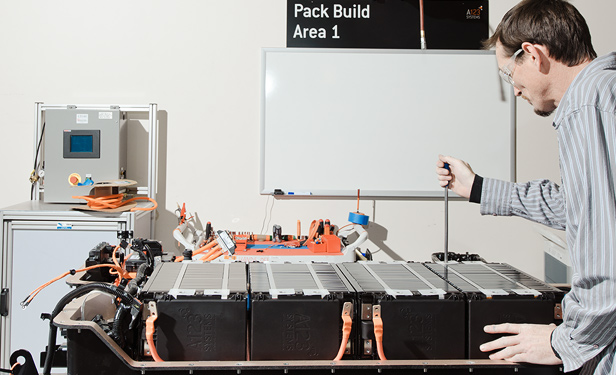A123 Systems Files for Bankruptcy

Once the darling of the clean-tech industry and a leading success story in the revival of advanced battery manufacturing in the United States, A123 Systems has announced that it is filing for bankruptcy and is selling off its main business, making batteries for vehicles, to rival battery maker Johnson Controls in a deal valued at $125 million. Johnson Controls will get all of A123’s automotive assets, which include its manufacturing facilities in Livonia and Romulus, Michigan, and a cathode manufacturing plant in China.
A123 has raised approximately a billion dollars over its lifetime, including a $249 million grant from the U.S. government as part of the Recovery Act of 2009 to build the factories in Michigan. The Livonia plant was touted as North America’s largest facility for producing lithium-ion automotive batteries when it was opened in 2010. The Department of Energy said at the time that it expected the facility to create 3,000 jobs in Michigan by 2012 and help establish the United States as a “global leader” in electric vehicles.
In the deal, Johnson Controls will not only acquire those Michigan factories but gain A123’s technology, its customers, and its production contracts. A123 had recently announced a deal with Chinese investors who planned to buy up to an 80 percent stake in the company. But in its announcement today, it said it was backing out of the deal “as a result of unanticipated and significant challenges to its completion.”
A123 was founded in 2001 to commercialize advanced lithium-ion technology developed by Yet-Ming Chiang, a materials scientist at MIT. It quickly rose from a promising startup to a major battery maker boasting production supply contracts with major vehicle manufacturers. It successfully went public in 2009 with an IPO that brought in about $400 million. But the company hasn’t been profitable. In addition to facing stiff competition from more established battery makers, it had problems with its key customer, Fisker Automotive, and was devastated by a major battery recall due to problems at one of its plants in Michigan (see “What Happened to A123?”).
Investors had first noticed A123 Systems because of its plans to make very high-energy lithium-ion batteries that the company hoped could increase storage capacity up to tenfold. But it quickly switched to another MIT technology, one that was easier to bring to market. Rather than storing more energy, this technology promised to be safer and more resilient than conventional lithium-ion batteries, which in rare cases could catch fire. Black & Decker put the batteries in its cordless power tools, and GM signed a development agreement with A123 and considered using them in its Chevrolet Volt. The company failed to win that contract but is the supplier for the Chevrolet Spark EV, due out next year.
A123 says it will continue operating its business as the transaction with Johnson Controls is finalized. Its supply contracts are up in the air pending the outcome of bankruptcy proceedings. A licensing agreement with Johnson Controls will allow the company to go forward with its businesses apart from vehicle batteries, including providing batteries for the grid and backup power. A123 says it is still figuring out what to do with those portions of its business.
Keep Reading
Most Popular
Large language models can do jaw-dropping things. But nobody knows exactly why.
And that's a problem. Figuring it out is one of the biggest scientific puzzles of our time and a crucial step towards controlling more powerful future models.
The problem with plug-in hybrids? Their drivers.
Plug-in hybrids are often sold as a transition to EVs, but new data from Europe shows we’re still underestimating the emissions they produce.
Google DeepMind’s new generative model makes Super Mario–like games from scratch
Genie learns how to control games by watching hours and hours of video. It could help train next-gen robots too.
How scientists traced a mysterious covid case back to six toilets
When wastewater surveillance turns into a hunt for a single infected individual, the ethics get tricky.
Stay connected
Get the latest updates from
MIT Technology Review
Discover special offers, top stories, upcoming events, and more.